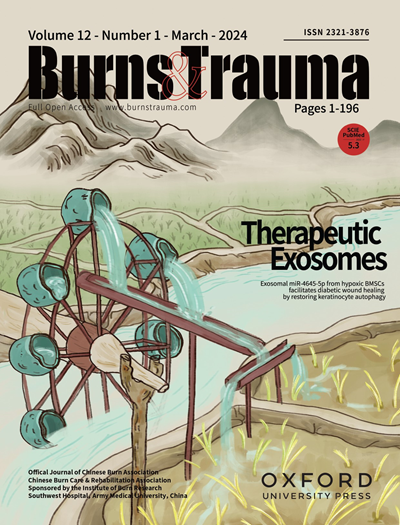Thermo-responsive cascade antimicrobial platform for precise biofilm removal and enhanced wound healing
IF 6.3
1区 医学
Q1 DERMATOLOGY
引用次数: 0
Abstract
Background Bacterial infection, tissue hypoxia and inflammatory response can hinder infected wound repair. This study aimed to develop a multifunctional specific therapeutic photo-activated release nanosystem [HMPB@MB@AuNPs@PMB@HA (HMAPH)] by loading photosensitizer methylene blue (MB) into hollow mesoporous Prussian blue nanostructures and modifying the surface with gold particles, polymyxin B (PMB) and hydrophilic hyaluronic acid. Methods The HMAPH was characterized using transmission electron microscopy, UV–vis, Fourier-transform infrared spectroscopy, X-ray diffraction and X-ray photon spectroscopy. The photothermal performance, iron ion release and free radical generation of the HMAPH were measured under different conditions to investigate its thermo-responsive cascade reaction. The antibacterial ability of HMAPH was investigated using live/dead fluorescence tests. The morphology and membrane integrity of Pseudomonas aeruginosa (P. aeruginosa) were investigated using transmission electron microscopy. The anti-biofilm activity of HMAPH was evaluated using crystal violet and SYBR Green I staining. Finally, we established a mouse model of a skin wound infected by P. aeruginosa to confirm the in vivo effectiveness of HMAPH. We used immunofluorescent staining, hematoxylin–eosin staining, Masson staining and enzyme-linked immunosorbent assay to examine whether HMAPH promoted wound healing and reduced inflammatory damage. Results In this study, hyaluronic acid was decomposed under the action of hyaluronidase. Also, the exposed nanomaterials specifically bound to the outer membrane of P. aeruginosa through PMB to increase the membrane sensitivity to photodynamic treatment. Under dual-light irradiation, a large amount of iron ions released by HMAPH underwent a Fenton reaction with H2O2 in bacteria to generate hydroxyl radicals (•OH), enabling direct killing of cells by hyperthermia. Additionally, the photodynamic activity of MB released by photo-induced activation led to the generation of reactive oxygen species, achieving synergistic and effective inhibition of P. aeruginosa. HMAPH also inhibited biofilm formation and downregulated the expression of virulence factors. In vivo experiments revealed that HMAPH accelerated the healing of P. aeruginosa-infected wounds by promoting angiogenesis and skin regeneration, inhibiting the inflammatory response and promoting M1 to M2 polarization. Conclusions Our study proposed a strategy against bacteria and biofilms through a synergistic photothermal–photodynamic–Fenton reaction, opening up new prospects for combating biofilm-associated infections.热响应级联抗菌平台可精确清除生物膜并促进伤口愈合
背景 细菌感染、组织缺氧和炎症反应会阻碍感染伤口的修复。本研究旨在将光敏剂亚甲基蓝(MB)载入中空介孔普鲁士蓝纳米结构,并用金颗粒、多粘菌素 B(PMB)和亲水性透明质酸修饰其表面,从而开发一种多功能特异性治疗光激活释放纳米系统[HMPB@MB@AuNPs@PMB@HA(HMAPH)]。方法 利用透射电子显微镜、紫外-可见光、傅立叶变换红外光谱、X 射线衍射和 X 射线光子光谱对 HMAPH 进行表征。在不同条件下测量了 HMAPH 的光热性能、铁离子释放和自由基生成,以研究其热响应级联反应。利用活/死荧光试验研究了 HMAPH 的抗菌能力。使用透射电子显微镜研究了铜绿假单胞菌(P. aeruginosa)的形态和膜完整性。使用结晶紫和 SYBR 绿 I 染色法评估了 HMAPH 的抗生物膜活性。最后,我们建立了铜绿假单胞菌感染皮肤伤口的小鼠模型,以证实 HMAPH 在体内的有效性。我们采用免疫荧光染色、苏木精-伊红染色、Masson 染色和酶联免疫吸附试验来检验 HMAPH 是否能促进伤口愈合和减轻炎症损伤。结果 在这项研究中,透明质酸在透明质酸酶的作用下被分解。同时,暴露的纳米材料通过 PMB 与铜绿假单胞菌的外膜特异性结合,从而提高了铜绿假单胞菌外膜对光动力治疗的敏感性。在双光照射下,HMAPH 释放的大量铁离子与细菌中的 H2O2 发生 Fenton 反应,生成羟自由基(-OH),从而通过热效应直接杀死细胞。此外,光诱导活化释放的甲基溴的光动力活性还导致生成活性氧,从而实现协同和有效抑制铜绿假单胞菌。HMAPH 还能抑制生物膜的形成并下调毒力因子的表达。体内实验表明,HMAPH 可促进血管生成和皮肤再生,抑制炎症反应,促进 M1 到 M2 极化,从而加速铜绿假单胞菌感染伤口的愈合。结论 我们的研究提出了一种通过协同光热-光动力-芬顿反应对抗细菌和生物膜的策略,为对抗生物膜相关感染开辟了新的前景。
本文章由计算机程序翻译,如有差异,请以英文原文为准。
求助全文
约1分钟内获得全文
求助全文
来源期刊

Burns & Trauma
医学-皮肤病学
CiteScore
8.40
自引率
9.40%
发文量
186
审稿时长
6 weeks
期刊介绍:
The first open access journal in the field of burns and trauma injury in the Asia-Pacific region, Burns & Trauma publishes the latest developments in basic, clinical and translational research in the field. With a special focus on prevention, clinical treatment and basic research, the journal welcomes submissions in various aspects of biomaterials, tissue engineering, stem cells, critical care, immunobiology, skin transplantation, and the prevention and regeneration of burns and trauma injuries. With an expert Editorial Board and a team of dedicated scientific editors, the journal enjoys a large readership and is supported by Southwest Hospital, which covers authors'' article processing charges.
 求助内容:
求助内容: 应助结果提醒方式:
应助结果提醒方式:


